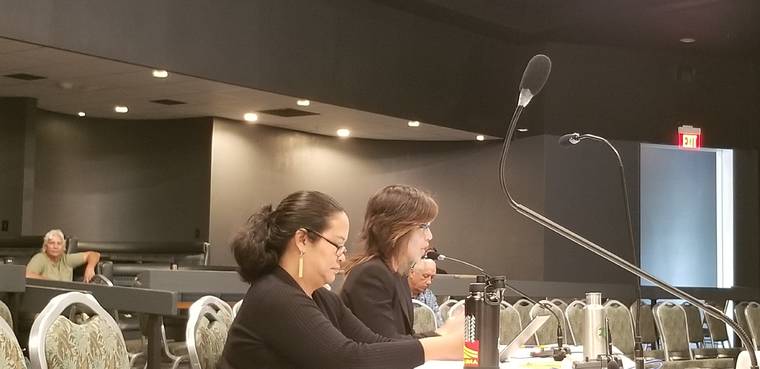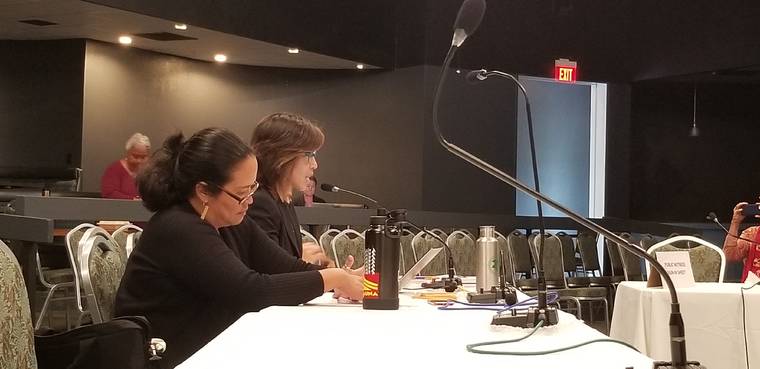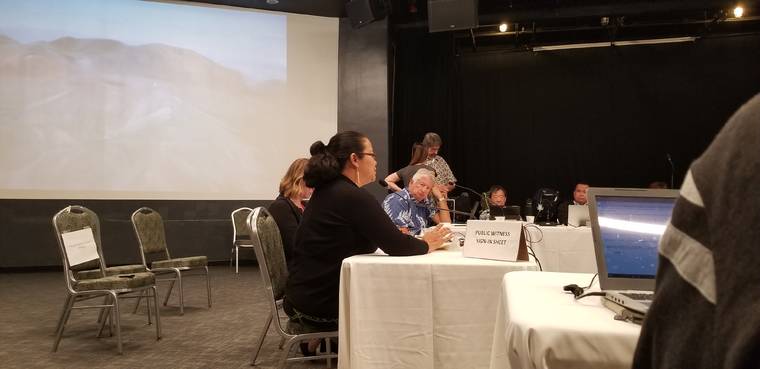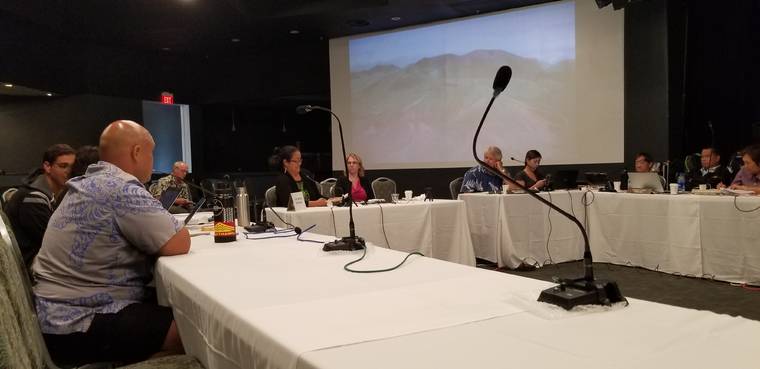Maunakea petition denied: Land commission votes 5-2 to reject request by two Hilo residents




Ahiena Kanahele (left) watches as Ku‘ulei Kanahele testifies. (Michael Brestovansky/Tribune-Herald)
HILO The state Land Use Commission voted Friday to deny a petition that requested a declaration that the use of land at Maunakea summit is improper for its current zoning.
HILO — The state Land Use Commission voted Friday to deny a petition that requested a declaration that the use of land at Maunakea summit is improper for its current zoning.
After a two-day meeting at the Grand Naniloa Resort, the Land Use Commission voted 5-2 to oppose the petition, which had been filed in September by Hilo residents Ku‘ulei and Ahiena Kanahele. The commissioners who voted against the petition all argued that the commission does not have the authority to do as the petition asks.
The petition requested that the commission issue three declaratory orders regarding the summit lands: First, that the number of observatories — considered by the petition to be industrial facilities — at Maunakea summit is consistent with land use within the urban district; second, that further industrial development proposed for the summit land must obtain a district boundary amendment reclassifying the land to the urban district; and finally, that the cumulative development on the summit is inconsistent with conservation district uses.
However, despite extensive testimony from members of the public, the Kanaheles and their attorney, most of the commission ultimately concluded that they do not have jurisdiction over the land.
“There is no subject-matter jurisdiction here,” said Commissioner Gary Okuda. “And we’ve got to follow the law even if we disagree with it.”
Okuda and most of his fellow commissioners agreed that the state statutes are clear that the Department of Land and Natural Resources has exclusive jurisdiction over the management of land in the conservation district.
“We can disagree if that’s a good thing, given what’s happened on Maunakea,” Okuda said.
While the commission is able to reclassify land from one district to another, Okuda said he knows of no statute that would give the commission the authority to require a property owner to request a boundary amendment.
Even as they denied the petition, all of the commissioners agreed that the current management of Maunakea lands has been questionable at best.
“Let’s be clear: Their management kinda sucks,” said Commissioner Arnold Wong.
Wong also expressed concerns throughout the meeting regarding the potential consequences of granting the petition. If the commission issued the declaratory orders, the DLNR would likely pursue a district boundary amendment seeking to rezone the summit land from the conservation to the urban district, which the petitioners had indicated they would oppose.
However, Wong said he felt that even the potential of rezoning the summit to urban would be dangerous. Land in the urban district is managed by the county, which Wong said might be less judicious than the state in enforcing regulations. Furthermore, rezoning the summit would set a precedent for developers or unscrupulous county officials to pursue similar petitions to change boundary classifications elsewhere in the state for their own ends, he said.
Commissioner Dan Giovanni questioned the petitioners’ motivation in seeking declaratory orders that would likely put the very classification of the summit — whose land is considered sacred to many Hawaiians, including the Kanaheles — in question.
“We want to see the process applied equally to university lands,” replied Bianca Isaki, the attorney representing the Kanaheles.
Isaki later said that the opportunity for the Kanaheles to oppose a district boundary amendment for the summit was the very relief they sought with the petition, which argued that the Kanaheles were denied a chance to oppose the gradual industrialization of the mountain.
The petition claimed that the Kanaheles would have aggressively opposed a district boundary amendment that would have reclassified the summit as urban. However, because the 12 observatories were authorized by repeated conservation district use permits over the course of decades, the Kanaheles were unable to do so, the petition read.
“If we had followed this process 50 years ago, we wouldn’t be in this mess,” said Chairman Jonathan Scheuer, who voted against rejecting the proposal.
Scheuer said he agrees that the summit land use is more consistent with the urban district — “If it looks like a duck, and quacks like a duck, then it’s a duck,” he said — and questioned who has the authority to make that judgment if the commission does not.
“I’m wrong every day before I get out of bed, so I could very well be wrong about this,” Scheuer said. “But I’d rather be told by the court that we’re wrong than be too cautious.”
Scheuer’s comments convinced Giovanni to also vote against rejecting the petition.
“I feel it’s extremely frustrating that the commissioners expressed their belief that the DLNR has mismanaged the land, but they’re still binded by laws to vote the way they did,” Ku‘ulei Kanahele said after the decision.
Isaki said she will pursue an appeal, potentially taking the case to the Hawaii Supreme Court. If it goes that far, Isaki said she would request that the court confirm that the commission does actually have authority to grant the petition, which would then take the case back before the commission.
Email Michael Brestovansky at mbrestovansky@hawaiitribune-herald.com.


